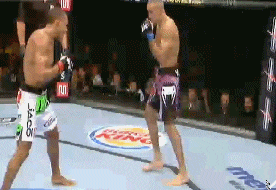Why didn't the ref stop it? He was clearing finished.EFC. its the main mma organisation in africa i think.
http://mmajunkie.com/2014/03/efc-af...dies-from-injuries-suffered-in-february-bout/
You are using an out of date browser. It may not display this or other websites correctly.
You should upgrade or use an alternative browser.
You should upgrade or use an alternative browser.
Study: MMA brain injury risk higher than boxing
- Thread starter Skooby
- Start date
More options
Who Replied?someone died in mma this month by the way. disgusting punches to the back of the head.

 13 strikes to the back of his head....what.the.fukk
13 strikes to the back of his head....what.the.fukkWhy didn't the ref stop it? He was clearing finished.
13 strikes to the back of his head....what.the.fukk
sorry guys but that guy wasnt the fighter that died. this was weeks after the fighter that died.
it was actually booto guylain that died in this video.
theres some misinformation in the stickied mma thread.
The Infamous
Superstar
Interesting view on the study/subject by Dr. Johnny Benjamin:
http://mmajunkie.com/2014/03/ask-the-fight-doc-thoughts-on-new-concussion-research-from-toronto/
I find their observations regarding older fighters and knockout/TKO history being significant risk factors extremely interesting. Also, 17 blows to the head, on average, before a TKO being called seems like a lot of punishment when you put it on paper!
Unfortunately, like me (in my earlier days) they took the bait and stepped into the pointless “Which is more dangerous?” debate. It reminds me of the thin vs. thick crust or Pat’s vs. Geno’s cheesesteaks debates.
The far more important and medically relevant question that unfortunately went unaddressed is, are combat sports following current concussion management guidelines and protocols, and the latest research regarding enhanced player safety? The clear answer is, not even close!
Their basic conclusion that MMA is more dangerous than these other contact sports does not consider the importance of the accumulation of damage over time due to sub-concussive blows. Research clearly suggests that far more important than the highlight-reel stoppages, it’s the hundreds or thousands of routine head strikes that do the real damage over time. Therefore, drawing your conclusion from accumulation of head strikes over time is far more likely to be predictive and useful than mere stoppages.
I believe that 10-second counts potentially subject an injured athlete to additional unnecessary head trauma. If a fighter is so injured that he needs 10 seconds to shake it off or gain his composure, the fight should be stopped.
The NFL experience shows that it takes a sideline concussion expert roughly seven to nine minutes to properly evaluate a potentially concussed athlete. Therefore, a 10-second count/assessment/evaluation is meaningless and probably dangerous.
Greater referee training regarding concussions is a must!
The more I learn about mTBI, the more I believe that sustaining repeated blows to the developing brain (specifically kids younger than 14) regardless of the activity or sport (tackle football, soccer headers, girls lacrosse without helmets, amateur boxing, full-contact martial arts, etc.) is not a good idea.
This paper is a good step to further the conversation and encourage stakeholders in combat sports to aggressively address the mTBI elephant in the room.
http://mmajunkie.com/2014/03/ask-the-fight-doc-thoughts-on-new-concussion-research-from-toronto/
Outside of UFC, e.g. Pride, you see the same thing. Fighters getting in additional hits to the head after the opponent is knocked unconscious, but hasn't hit the floor yet.
I'd have to say MMA needs two refs.
I'd have to say MMA needs two refs.
Mr. Somebody
Friend Of A Friend

No brain damage here.
 I try to tell friends. mma is a very dangerous sport which is why it is a pinnacle of self defense and should be respected.
I try to tell friends. mma is a very dangerous sport which is why it is a pinnacle of self defense and should be respected.threattonature
Veteran
That's always been Dana's argument. That boxing is more damaging since they are taking a lot more hits. And that while MMA probably has more vicious knockdowns those aren't nearly as damaging as the accumulation of punishment that occurs in boxing.Interesting view on the study/subject by Dr. Johnny Benjamin:
http://mmajunkie.com/2014/03/ask-the-fight-doc-thoughts-on-new-concussion-research-from-toronto/